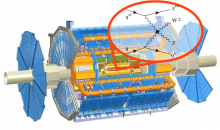Quarks observed playing with lightsabers
Two among the rarest processes probed so far at the Large Hadron Collider (LHC), the scattering between W and Z bosons emitted by quarks in proton-proton collisions, have been established by the ATLAS experiment at CERN.
W and Z bosons play the same mediating role for the weak nuclear interaction as photons do for electromagnetism. But, while two light beams of photons, like lasers, can cross without ever interacting, beams of W and Z bosons “bounce”, or scatter, one on the other, like tiny “lightsabers”.
One of the main motivations for the construction of the LHC at CERN was precisely the study of these processes called “vector boson scattering”. For such a process to take place, two W or Z bosons must be emitted simultaneously by two quarks contained respectively in each of the two protons of a collision. These bosons, particles of extremely short life time, can “fly” over a maximum distance of 0.1×10-15 m, only one tenth of the proton size. This gives them very little time, and luck, to interact with each other. Such an unlikely interaction occurs only about once a day in LHC operation, that is, about once every 20,000 billion proton-proton interactions.
Using 2015 and 2016 data, ATLAS experiment has observed this scattering of two vector bosons W±Z and W±W±.
44 diffusion events W±Z were isolated, with a statistical sensitivity of 5.6 standard deviations, thus beyond the threshold of 5 standard deviations traditionally required for a discovery. This threshold means that if the W±Z scattering does not actually exist, the experiment had at most about one in 3.5 million chance to observe it anyway by mistake. For the W±W± scattering, 60 events were identified, with a statistical sensitivity of 6.9 standard deviations.
These confirmations of the existence of vector boson scattering processes mark the beginning of a new chapter in the study of the Standard Model of Particle Physics and pave the way for even deeper inspections of the fundamental interactions that govern our universe.
These results were presented by the ATLAS collaboration at the ICHEP International Conference in Seoul in early July 2018.

ATLAS team at LAPP played a major role in these scientific advances. The first observation so far of the scattering of two W and Z vector bosons is the result of the work of ATLAS team at LAPP. This result could only be achieved through the joint use of machine learning and advanced statistical methods, two of the group’s areas of expertise. This result is also the result of a long preparation process and a commitment of more than five years of the team on this subject.
A physicist from the team also coordinated the internal review of the ATLAS collaboration for the observation of the scattering of two W±W± vector bosons of the same charge.
The LAPP ATLAS team benefited from the financial support of Labex ENIGMASS for this research program.
References:
- http://atlas.cern/updates/physics-briefing/weak-lightsabers
- ATLAS Collaboration, Observation of electroweak W±Z boson pair production in association with two jets in pp collisions at √s = 13 TeV with the ATLAS Detector (ATLAS-CONF-2018-033)
- ATLAS Collaboration, Observation of electroweak production of a same-sign W boson pair in association with two jets in proton-proton collisions at 13 TeV with the ATLAS detector (ATLAS-CONF-2018-030)
Contact: - Emmanuel Sauvan: Manager of ATLAS team at LAPP
Thumbnail picture: - Graphic representation of the ATLAS detector and a scattering diagram of two W and Z bosons. Image: ATLAS Collaboration/CERN


